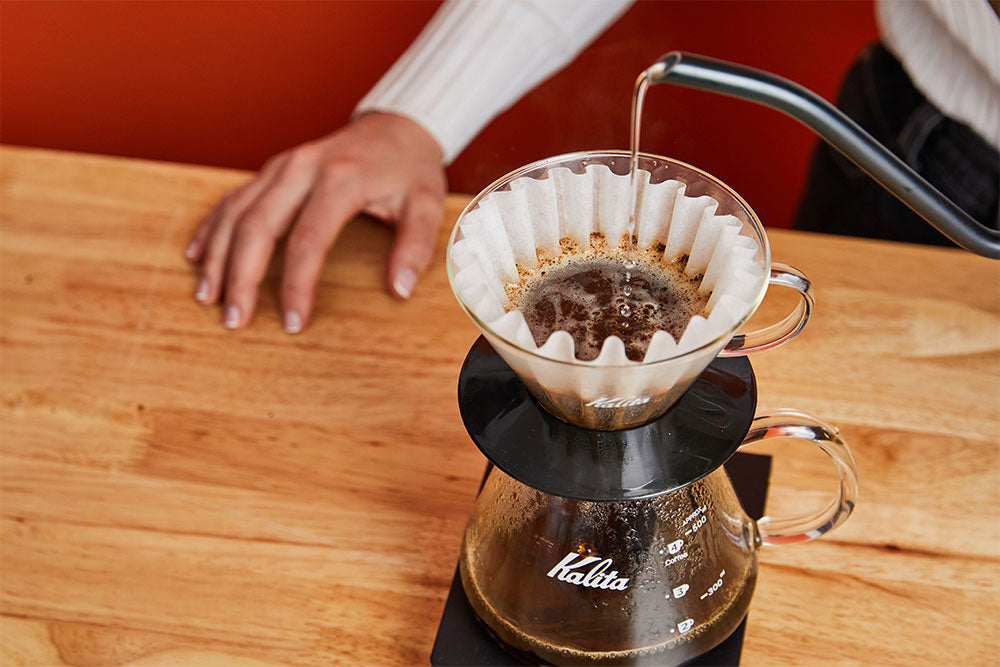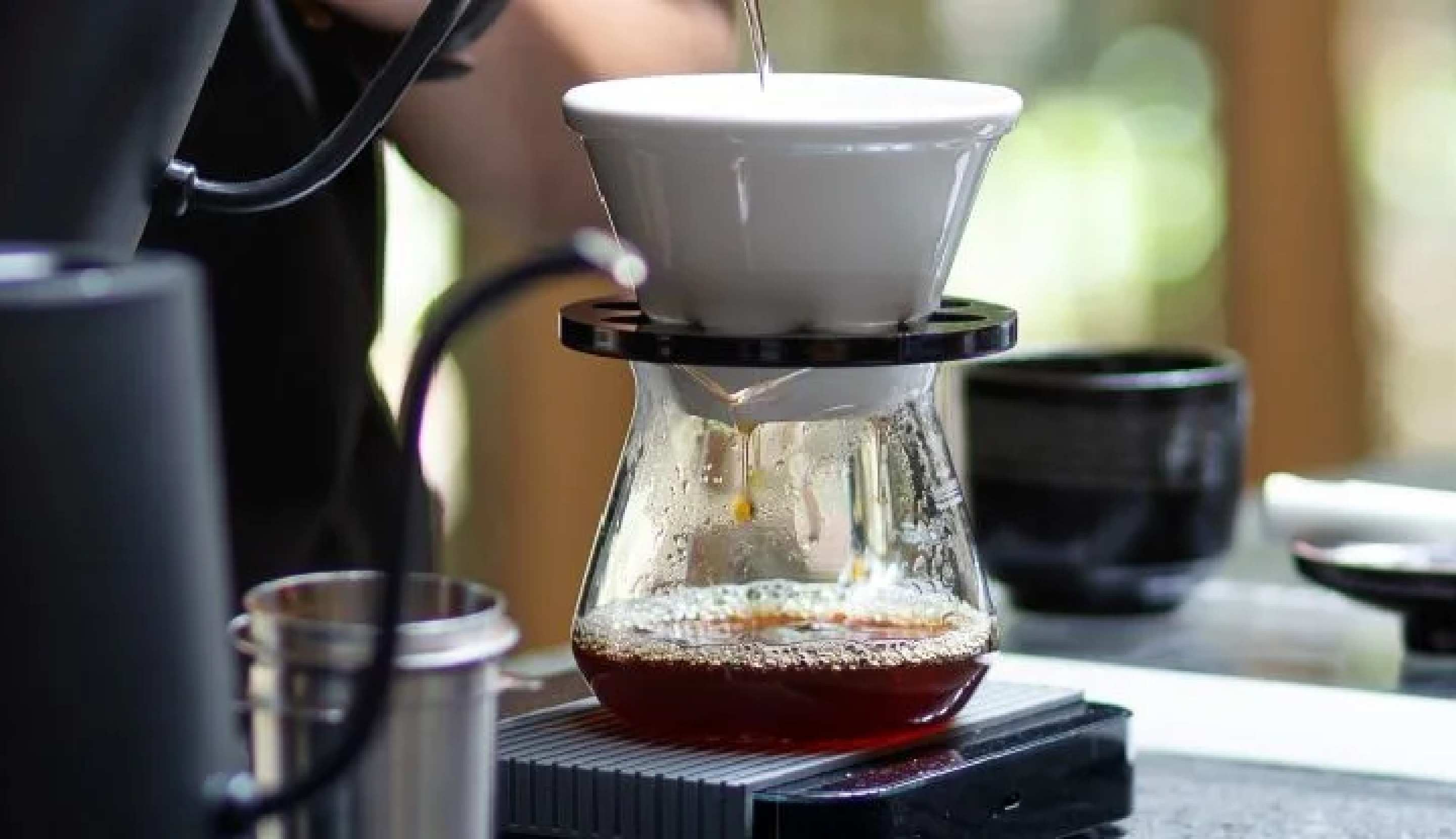As an Amazon Associate CoffeeXplore.com earns from qualifying purchases.
What is Drip Coffee?: Brewing Method, History, Differences, and Tips
Drip coffee is a staple for many coffee lovers, but understanding its nuances can be surprisingly complex. Have you ever wondered why this method is so prevalent, or how it compares to other brewing techniques? Drip coffee is a brewing method where hot water drips through coffee grounds, extracting flavors and producing a clean, consistent cup of coffee.
Curious about the differences between drip coffee and pour-over, or wondering how the process affects the flavor? In this guide, we’ll dive deep into the world of drip coffee, exploring its history, equipment, and tips for perfecting your brew. Discover why drip coffee remains a beloved choice and learn how to master this method with expert insights and practical advice. Keep reading to uncover everything you need to know about this essential coffee brewing technique.
Key Facts:
1. Drip coffee originated in the early 20th century with the invention of the paper filter.
2. The brewing process involves hot water passing through ground coffee and a filter.
3. Automatic drip coffee makers are the most common household brewing method in the US.
4. Drip coffee typically has a cleaner, less intense flavor compared to other brewing methods.
5. Water temperature and grind size significantly impact the quality of drip coffee.
What is Drip Coffee?

A typical drip coffee setup in action – source
Drip coffee is a brewing method that involves pouring hot water over ground coffee beans, allowing it to seep through and drip into a carafe or pot below. This simple yet effective technique has become a cornerstone of coffee culture, especially in North America. But what exactly makes drip coffee unique, and why has it become so popular?
Basic Definition and Process
The drip coffee process is straightforward but relies on precise execution for the best results. Here’s a breakdown of how it works:
- Grinding: Coffee beans are ground to a medium coarseness.
- Filtering: The grounds are placed in a filter (paper or reusable).
- Heating: Water is heated to the optimal temperature (195°F to 205°F).
- Pouring: Hot water is poured over the grounds, either manually or automatically.
- Extraction: As water passes through the grounds, it extracts flavors and oils.
- Dripping: The brewed coffee drips into a carafe or pot below.
This method produces a clean, smooth cup of coffee that’s less intense than espresso but more flavorful than instant coffee. The brewing process allows for consistent extraction, resulting in a balanced flavor profile that many coffee drinkers prefer.
Historical Background of Drip Coffee
The story of drip coffee is intertwined with the evolution of coffee culture itself. While coffee has been enjoyed for centuries, the drip method as we know it today is a relatively recent innovation.
Key milestones in drip coffee history:
- 1908: Melitta Bentz invents the paper coffee filter in Germany.
- 1930s: The first electric drip coffee maker is introduced.
- 1970s: Mr. Coffee launches, revolutionizing home brewing.
These innovations transformed coffee from a labor-intensive process to an easily accessible daily ritual for millions. The convenience and consistency of drip coffee played a significant role in its rapid adoption, especially in busy households and offices.
“The invention of the paper filter by Melitta Bentz was a game-changer for coffee brewing, paving the way for the modern drip coffee we know today.” – James Hoffmann, World Barista Champion
The Evolution of Drip Coffee Brewing Methods
Over the years, drip coffee brewing has evolved from manual pour-over techniques to sophisticated automatic machines. This evolution has been driven by a desire for convenience without sacrificing quality.
Manual vs. Automatic Drip Coffee:
| Manual Methods | Automatic Machines |
|---|---|
| Chemex | Standard Drip Makers |
| Hario V60 | Programmable Brewers |
| Kalita Wave | Smart Coffee Makers |
Each method has its pros and cons, but they all share the fundamental principle of gravity-fed water passing through coffee grounds. The choice between manual and automatic often comes down to personal preference, time constraints, and the desire for control over the brewing process.
Tip: Experiment with both manual and automatic methods to find your perfect cup. Manual brewing offers more control, while automatic machines provide consistency and convenience.
The Role of Drip Coffee in Modern Coffee Culture
Drip coffee has become more than just a way to brew coffee; it’s a cultural phenomenon. Its accessibility has made it a staple in homes, offices, and cafes worldwide. But how does it fit into the broader coffee landscape?
- Everyday Convenience: For many, drip coffee is synonymous with their morning routine.
- Specialty Coffee Movement: High-end drip coffee has found its place alongside espresso in third-wave coffee shops.
- Sustainability: The rise of reusable filters has made drip coffee more eco-friendly.
- Customization: From bean selection to grind size, drip coffee allows for personal tweaking.
Despite the rise of espresso-based drinks and cold brew, drip coffee remains a beloved choice for its simplicity and reliability. It’s a testament to the enduring appeal of a well-brewed cup of joe.
How Does Drip Coffee Work?
Understanding the mechanics behind drip coffee can help you appreciate your morning cup even more. Let’s break down the process and explore the science that makes this brewing method so effective.
The Brewing Process Explained
The drip coffee brewing process is a delicate dance of temperature, time, and gravity. Here’s a step-by-step breakdown:
- Water Heating: The process begins with heating water to the ideal temperature, typically between 195°F and 205°F (90°C to 96°C).
-
Initial Contact: As hot water hits the coffee grounds, it causes them to expand and release gases in a process called “blooming.”
-
Extraction: The hot water dissolves soluble compounds in the coffee grounds, extracting flavors, oils, and caffeine.
-
Filtration: The brewed coffee passes through a filter, which traps the grounds and allows the liquid to drip through.
-
Collection: The filtered coffee collects in a carafe or pot below, ready for serving.
This seemingly simple process is actually a complex interplay of chemical reactions and physical properties that result in your perfect cup of joe.
The Science Behind Drip Coffee Extraction
The magic of drip coffee lies in its extraction process. But what exactly is happening at a molecular level?
Key factors in extraction:
- Solubility: Different compounds in coffee dissolve at varying rates.
- Temperature: Higher temperatures extract flavors more quickly but can lead to over-extraction if not controlled.
- Contact Time: The duration of water-to-coffee contact affects the strength and flavor profile.
- Pressure: Unlike espresso, drip coffee relies solely on gravity, resulting in a gentler extraction.

Essential components for drip coffee extraction – source
According to a study by the Specialty Coffee Association, the ideal extraction yield for drip coffee is between 18% and 22% of the coffee’s mass. This sweet spot ensures a balanced cup without bitterness or weakness.
The Importance of Coffee-to-Water Ratio
Getting the right coffee-to-water ratio is crucial for brewing the perfect cup of drip coffee. Too little coffee, and you’ll end up with a weak, watery brew. Too much, and you’ll have an overpowering, bitter cup.
The Golden Ratio:
A good starting point is the “Golden Ratio” of 1:16 – that’s 1 gram of coffee for every 16 grams of water. However, personal preference plays a big role here.
| Strength | Coffee:Water Ratio |
|---|---|
| Mild | 1:17 |
| Medium | 1:16 |
| Strong | 1:15 |
Tip: Use a kitchen scale for precise measurements. This level of accuracy can significantly improve the consistency of your brews.
How Different Variables Affect the Flavor
The beauty of drip coffee lies in its versatility. By adjusting various factors, you can dramatically change the flavor profile of your brew. Let’s explore some key variables:
- Grind Size:
- Finer grinds increase extraction but can lead to bitterness.
- Coarser grinds reduce extraction but may result in weak coffee.
- Water Temperature:
- Hotter water extracts flavors more quickly but can over-extract.
- Cooler water leads to slower extraction and potentially under-extracted coffee.
- Brewing Time:
- Longer brewing times increase extraction but may introduce bitterness.
- Shorter times can result in weak, under-extracted coffee.
- Filter Type:
- Paper filters remove more oils, resulting in a cleaner cup.
- Metal filters allow more oils through, creating a fuller-bodied brew.
- Bean Roast Level:
- Lighter roasts often have brighter, more acidic flavors.
- Darker roasts tend to have bolder, more robust flavors.
By experimenting with these variables, you can fine-tune your drip coffee to match your personal taste preferences. Remember, the perfect cup is subjective – what matters most is what tastes best to you!
For more detailed information on how these variables interact, check out this comprehensive guide on drip coffee brewing.
Equipment Needed for Drip Coffee
Brewing the perfect cup of drip coffee isn’t just about the beans and water – it’s also about having the right equipment. Let’s explore the various tools you’ll need to master this popular brewing method.
Automatic Drip Coffee Makers
Automatic drip coffee makers are the workhorses of many kitchens and offices. They offer convenience and consistency, making them a popular choice for daily brewing.
Key features to look for:
- Programmable Settings: Set your coffee to brew automatically at a specific time.
- Temperature Control: Ensures water is heated to the optimal brewing temperature.
- Pause and Serve: Allows you to pour a cup mid-brew.
- Water Filter: Improves water quality for better-tasting coffee.
- Thermal Carafe: Keeps coffee hot without burning it.
Popular brands like Mr. Coffee, Cuisinart, and Breville offer a range of options to suit different needs and budgets. For those interested in exploring high-end automatic brewers, the Technivorm Moccamaster is often considered the gold standard in drip coffee makers.
Manual Drip Coffee Equipment
For coffee enthusiasts who enjoy a more hands-on approach, manual drip coffee methods offer greater control over the brewing process. Here are some popular manual brewing devices:
- Chemex:
- Known for its elegant design and thick filters that produce a clean, bright cup.
- Ideal for brewing larger quantities.
- Hario V60:
- Cone-shaped dripper that allows for precise pouring and extraction.
- Produces a clean, flavorful cup.
- Kalita Wave:
- Flat-bottomed dripper that provides consistent extraction.
- Known for its forgiving nature, making it great for beginners.

A manual drip coffee setup featuring a pour-over dripper – source
Each of these methods has its unique characteristics and learning curve. Experimenting with different manual brewers can be a fun way to explore the nuances of drip coffee.
Filters: Paper vs. Metal
The choice between paper and metal filters can significantly impact the flavor and body of your drip coffee.
Paper Filters:
– Trap more oils and sediment, resulting in a cleaner, brighter cup.
– Available in bleached (white) and unbleached (brown) varieties.
– Disposable, making cleanup easy but less eco-friendly.
Metal Filters:
– Allow more oils to pass through, producing a fuller-bodied coffee.
– Reusable, making them more environmentally friendly.
– Require regular cleaning to prevent flavor contamination.
Tip: Try both types to see which you prefer. Some coffee lovers even keep both on hand for different brewing experiences.
Essential Accessories
To elevate your drip coffee game, consider investing in these accessories:
- Burr Grinder: Ensures consistent grind size for optimal extraction.
- Kitchen Scale: Allows for precise measurement of coffee and water.
- Gooseneck Kettle: Provides control over water flow for manual brewing methods.
- Thermometer: Helps achieve the ideal water temperature.
- Airtight Container: Keeps your coffee beans fresh.
These tools can make a significant difference in the quality and consistency of your brews. For more information on essential coffee gear, check out this guide to coffee equipment.
How to Choose the Right Drip Coffee Maker
Selecting the perfect drip coffee maker depends on your specific needs and preferences. Here are some factors to consider:
- Capacity: How many cups do you typically brew at once?
- Programmability: Do you want to set it and forget it?
- Brew Strength Control: Some machines offer options for stronger or milder brews.
- Thermal vs. Glass Carafe: Thermal keeps coffee hot longer without burning it.
- Price: Drip coffee makers range from budget-friendly to high-end.
- Additional Features: Consider options like built-in grinders or milk frothers.
Remember, the best coffee maker is the one that fits your lifestyle and helps you consistently brew coffee you enjoy. Don’t be afraid to read reviews and compare different models before making your choice.
Variations of Drip Coffee
While the basic principle of drip coffee remains consistent, there are several variations and related brewing methods that coffee enthusiasts should know about. Let’s explore these different approaches to brewing and how they compare to traditional drip coffee.
Pour-Over Coffee vs. Drip Coffee
Pour-over coffee and drip coffee are often confused, but there are some key differences:
Pour-Over Coffee:
– Manual brewing method
– Requires more skill and attention
– Offers greater control over extraction
– Often preferred for single-cup brewing
Drip Coffee:
– Can be manual or automatic
– Generally more convenient, especially with automatic machines
– Ideal for brewing larger quantities
– More consistent results, especially with automatic brewers
While both methods involve hot water passing through ground coffee and a filter, pour-over allows for more precision in factors like water distribution and brewing time. Many coffee aficionados prefer pour-over for its ability to highlight the nuanced flavors of specialty coffees.
Cold Drip Coffee: A Different Approach
Cold drip coffee, not to be confused with cold brew, is a unique variation on the drip method:
- Uses cold or room temperature water
- Brewing process can take several hours
- Produces a smooth, less acidic coffee
- Often has a higher caffeine content due to longer extraction time

A typical cold drip coffee setup – source
Cold drip coffee is made using a specialized tower that allows water to slowly drip over coffee grounds. This method is prized for its ability to extract flavors without the bitterness often associated with hot brewing methods.
Tip: If you’re curious about cold drip coffee, you can find more information about its unique brewing process and flavor profile on our cold brew vs. drip coffee comparison page.
Differences Between Drip Coffee and Other Brewing Methods
To truly appreciate drip coffee, it’s helpful to understand how it compares to other popular brewing methods:
- Drip vs. French Press:
- French Press uses immersion brewing, resulting in a fuller-bodied coffee
- Drip coffee is typically cleaner and less oily due to paper filtration
- Drip vs. Espresso:
- Espresso uses pressure for a more concentrated, intense flavor
- Drip coffee has a lighter body and is consumed in larger quantities
- For a detailed comparison, check out our drip coffee vs. espresso guide
- Drip vs. Percolator:
- Percolators recirculate brewed coffee through the grounds, often resulting in over-extraction
- Drip coffee provides more consistent results and less bitterness
- Drip vs. AeroPress:
- AeroPress uses pressure and shorter brew times for a quick, strong cup
- Drip coffee generally has a cleaner taste and is better for larger quantities
Each method has its unique characteristics, and the best choice often comes down to personal preference and specific brewing needs.
Popular Drip Coffee Recipes Around the World
Drip coffee serves as the base for many beloved coffee drinks worldwide. Here are some popular variations:
- Café Americano: Essentially drip coffee, but made with espresso and hot water
- Café au Lait: Equal parts drip coffee and steamed milk
- Red Eye: Drip coffee with a shot of espresso added
- Vietnamese Drip Coffee: Strong drip coffee served over ice with sweetened condensed milk
- Japanese Iced Coffee: Hot drip coffee brewed directly over ice for a refreshing cold drink
These recipes showcase the versatility of drip coffee and how it’s adapted to different cultural preferences around the globe.
Tips for Brewing the Perfect Drip Coffee
Now that we’ve explored what drip coffee is and its variations, let’s dive into how you can brew the perfect cup at home. With a few key tips and techniques, you can elevate your drip coffee game significantly.
Selecting the Right Coffee Beans
The foundation of great drip coffee starts with high-quality beans:
- Freshness: Look for beans with a recent roast date.
- Roast Level: Medium roasts often work best for drip coffee, balancing flavor and acidity.
- Origin: Single-origin beans can highlight unique flavor profiles.
- Whole Beans: Buy whole beans and grind them just before brewing for maximum freshness.
Pro Tip: Experiment with different beans to find your preferred flavor profile. Keep a coffee journal to track your favorites!
The Importance of Grinding Size
Grind size is crucial for proper extraction in drip coffee:
- Too Fine: Can lead to over-extraction and bitterness
- Too Coarse: May result in under-extraction and weak coffee
For drip coffee, aim for a medium grind – about the consistency of sand. This allows for optimal extraction during the typical drip brewing time.
Optimal Water Temperature and Quality
Water makes up 98% of your coffee, so its quality and temperature are vital:
- Temperature: Aim for 195°F to 205°F (90°C to 96°C)
- Quality: Use filtered water for the best taste
- Mineral Content: Soft water can lead to under-extraction, while hard water can over-extract
According to the Specialty Coffee Association, the ideal water for coffee should have a TDS (Total Dissolved Solids) reading between 75-250 ppm.
Timing and Extraction: Getting the Brew Just Right
Proper timing is essential for balanced extraction:
- Total Brew Time: Aim for 3-4 minutes for a full pot
- Bloom Time: Allow 30-45 seconds for degassing when using freshly roasted beans
- Pouring Technique (for manual brewing): Use a steady, circular pour to ensure even extraction
Remember, these are guidelines. Feel free to adjust based on your taste preferences and the specific coffee you’re using.
Common Mistakes to Avoid in Drip Coffee Brewing
Even experienced coffee lovers can fall into these common pitfalls:
- Using stale beans: Always opt for freshly roasted coffee.
- Incorrect grind size: Adjust your grind to match your brewing method.
- Eyeballing measurements: Use a scale for consistent results.
- Neglecting machine maintenance: Regular cleaning prevents off-flavors.
- Reheating coffee: This can lead to a bitter taste. Brew fresh when possible.
By avoiding these mistakes and following the tips above, you’ll be well on your way to brewing excellent drip coffee at home. For more in-depth brewing tips, check out our guide on making the best drip coffee.
Flavor Profile of Drip Coffee
Understanding the flavor profile of drip coffee can help you appreciate its nuances and choose the right beans and brewing methods for your taste preferences.
Understanding the Flavor Spectrum of Drip Coffee
Drip coffee typically offers a well-balanced flavor profile, characterized by:
- Clarity: The paper filter removes most oils, resulting in a clean taste.
- Body: Medium-bodied compared to other brewing methods.
- Acidity: Moderate acidity, which can vary based on the beans and roast level.
- Sweetness: Subtle sweetness, especially in medium roasts.
- Aftertaste: Generally clean and brief.
The flavor spectrum can range from bright and fruity to rich and chocolatey, depending on the coffee beans used and brewing variables.
How Roast Level Affects the Taste
The roast level of your coffee beans significantly impacts the flavor of your drip coffee:
- Light Roasts: Higher acidity, floral and fruity notes, more complex flavors
- Medium Roasts: Balanced flavor, slight sweetness, often nutty or chocolatey
- Dark Roasts: Bold, less acidic, often with roasted or caramel notes
Experiment with different roast levels to find your preferred flavor profile. Many coffee enthusiasts find that medium roasts work well for drip coffee, offering a good balance of flavors.
Comparing the Flavor of Drip Coffee to Other Methods
Each brewing method brings out different characteristics in coffee. Here’s how drip coffee compares:
| Brewing Method | Body | Acidity | Flavor Clarity |
|---|---|---|---|
| Drip Coffee | Medium | Moderate | High |
| French Press | Full | Low | Low |
| Espresso | Full | Low | Moderate |
| Pour-Over | Light to Medium | High | Very High |
Drip coffee often strikes a balance between these extremes, making it a versatile and widely appealing brewing method.
How to Enhance the Flavor of Your Drip Coffee
To get the most out of your drip coffee, consider these flavor-enhancing tips:
- Use fresh, high-quality beans: This is the foundation of great coffee flavor.
- Grind just before brewing: This preserves the coffee’s aromatic compounds.
- Experiment with water temperature: Slight adjustments can bring out different flavors.
- Try different filters: Paper vs. metal filters can significantly impact taste and body.
- Clean your equipment regularly: This prevents old coffee oils from tainting your brew.
Remember, the perfect cup of coffee is subjective. Don’t be afraid to experiment and adjust based on your personal preferences.
For more insights on how different factors affect coffee flavor, check out our comparison of drip coffee and Americano.
The Cultural Impact of Drip Coffee
Drip coffee isn’t just a beverage; it’s a cultural phenomenon that has shaped social norms, work habits, and even art. Let’s explore the far-reaching influence of this humble brewing method.
Drip Coffee’s Influence in Different Regions
While drip coffee originated in Europe, its impact has been felt globally:
- United States: Drip coffee became synonymous with the American coffee culture, particularly with the rise of diners and office coffee pots.
- Japan: The pour-over method, a manual form of drip coffee, has been elevated to an art form.
- Scandinavia: These countries consistently rank among the highest coffee consumers, with drip coffee being a staple.
- Turkey: While Turkish coffee remains popular, drip coffee has gained traction in urban areas.
The global spread of drip coffee has led to interesting fusions of local coffee traditions with this brewing method.
The Role of Drip Coffee in the Specialty Coffee Movement
Drip coffee has played a significant role in the specialty coffee movement:
- Accessibility: It’s an easy entry point for people exploring specialty coffee.
- Flavor Clarity: The clean cup profile allows for appreciation of subtle flavor notes.
- Brewing Control: Manual drip methods offer precision for coffee enthusiasts.
- Cupping Method: Many coffee professionals use a form of drip brewing for taste testing.
The specialty coffee movement has, in turn, elevated drip coffee, with high-end cafes offering meticulously prepared pour-over coffees alongside espresso drinks.
Drip Coffee in Popular Culture and Media
Drip coffee has left an indelible mark on popular culture:
- TV and Movies: The office coffee pot is a common backdrop in workplace scenes.
- Literature: Many writers have waxed poetic about their relationship with drip coffee.
- Art: Coffee and coffee makers have been subjects in various art forms.
- Music: Numerous songs reference coffee, often implying drip coffee.
From the “Central Perk” coffeehouse in Friends to the iconic “But first, coffee” slogan, drip coffee has become a cultural shorthand for starting the day or taking a break.
FAQs About What is Drip Coffee?
Q: What is the difference between drip coffee and regular coffee?
A: Drip coffee is a specific brewing method where hot water passes through ground coffee beans and a filter. “Regular coffee” is a general term that can refer to any brewing method, but in many contexts, it’s synonymous with drip coffee, especially in the United States.
Q: Is drip coffee the same as a pour-over?
A: While similar, they’re not exactly the same. Both involve hot water passing through coffee grounds and a filter, but pour-over is a manual method offering more control over variables like water flow and temperature. Drip coffee often refers to automatic machines, though manual drip methods exist.
Q: How do you make drip coffee manually?
A: To make drip coffee manually:
1. Place a filter in a dripper over a cup or carafe.
2. Add medium-ground coffee to the filter.
3. Heat water to about 200°F (93°C).
4. Pour a small amount of water over the grounds to “bloom” the coffee.
5. After 30 seconds, slowly pour the remaining water in a circular motion.
6. Allow all the water to drip through before removing the filter.
Q: What equipment is needed for drip coffee?
A: For automatic drip coffee, you need:
– An automatic drip coffee maker
– Paper filters
– Ground coffee
– Water
For manual drip coffee, you need:
– A pour-over dripper (like Hario V60 or Chemex)
– Paper filters
– A kettle (preferably gooseneck)
– Ground coffee
– A scale (optional but recommended)
Q: How does cold drip coffee differ from cold brew?
A: Cold drip coffee uses a slow dripping process of cold water through coffee grounds, typically taking several hours. Cold brew involves steeping coffee grounds in cold water for 12-24 hours. Cold drip often results in a cleaner, less acidic taste compared to cold brew, which tends to be fuller-bodied.
Summary
Drip coffee, with its straightforward brewing process and consistent results, has become a cornerstone of coffee culture worldwide. We’ve explored its definition, history, and the science behind its brewing process, uncovering the nuances that make this method so popular.
From the evolution of brewing equipment to the impact of variables like grind size and water temperature, we’ve seen how drip coffee can be both simple and complex. We’ve compared it to other brewing methods, highlighting its unique characteristics and flavor profile.
Whether you’re using an automatic machine for convenience or embracing the precision of manual pour-over, drip coffee offers a world of flavor to explore. Remember, the perfect cup is subjective – don’t be afraid to experiment with different beans, roasts, and brewing variables to find your ideal brew.
As we’ve seen, drip coffee is more than just a beverage; it’s a cultural phenomenon that has shaped social norms and work habits across the globe. Its accessibility and versatility have made it a staple in homes, offices, and cafes alike.
So, the next time you brew or order a cup of drip coffee, take a moment to appreciate the rich history and careful process behind this seemingly simple drink. What aspects of drip coffee brewing will you explore next? Perhaps it’s time to try a new roast or experiment with a manual brewing method. The world of drip coffee is vast and inviting – happy brewing!—




